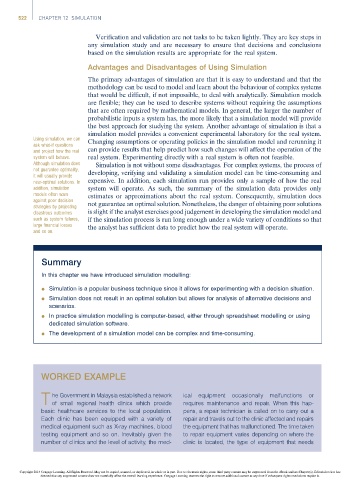Page 542 -
P. 542
522 CHAPTER 12 SIMULATION
Verification and validation are not tasks to be taken lightly. They are key steps in
any simulation study and are necessary to ensure that decisions and conclusions
based on the simulation results are appropriate for the real system.
Advantages and Disadvantages of Using Simulation
The primary advantages of simulation are that it is easy to understand and that the
methodology can be used to model and learn about the behaviour of complex systems
that would be difficult, if not impossible, to deal with analytically. Simulation models
are flexible; they can be used to describe systems without requiring the assumptions
that are often required by mathematical models. In general, the larger the number of
probabilistic inputs a system has, the more likely that a simulation model will provide
the best approach for studying the system. Another advantage of simulation is that a
simulation model provides a convenient experimental laboratory for the real system.
Using simulation, we can Changing assumptions or operating policies in the simulation model and rerunning it
ask what-if questions
and project how the real can provide results that help predict how such changes will affect the operation of the
system will behave. real system. Experimenting directly with a real system is often not feasible.
Although simulation does Simulation is not without some disadvantages. For complex systems, the process of
not guarantee optimality,
it will usually provide developing, verifying and validating a simulation model can be time-consuming and
near-optimal solutions. In expensive. In addition, each simulation run provides only a sample of how the real
addition, simulation system will operate. As such, the summary of the simulation data provides only
models often warn estimates or approximations about the real system. Consequently, simulation does
against poor decision
strategies by projecting not guarantee an optimal solution. Nonetheless, the danger of obtaining poor solutions
disastrous outcomes is slight if the analyst exercises good judgement in developing the simulation model and
such as system failures, if the simulation process is run long enough under a wide variety of conditions so that
large financial losses the analyst has sufficient data to predict how the real system will operate.
and so on.
Summary
In this chapter we have introduced simulation modelling:
l Simulation is a popular business technique since it allows for experimenting with a decision situation.
l Simulation does not result in an optimal solution but allows for analysis of alternative decisions and
scenarios.
l In practice simulation modelling is computer-based, either through spreadsheet modelling or using
dedicated simulation software.
l The development of a simulation model can be complex and time-consuming.
WORKED EXAMPLE
he Government in Malaysia established a network ical equipment occasionally malfunctions or
T of small regional health clinics which provide requires maintenance and repair. When this hap-
basic healthcare services to the local population. pens, a repair technician is called on to carry out a
Each clinic has been equipped with a variety of repair and travels out to the clinic affected and repairs
medical equipment such as X-ray machines, blood the equipment that has malfunctioned. The time taken
testing equipment and so on. Inevitably given the to repair equipment varies depending on where the
number of clinics and the level of activity, the med- clinic is located, the type of equipment that needs
Copyright 2014 Cengage Learning. All Rights Reserved. May not be copied, scanned, or duplicated, in whole or in part. Due to electronic rights, some third party content may be suppressed from the eBook and/or eChapter(s). Editorial review has
deemed that any suppressed content does not materially affect the overall learning experience. Cengage Learning reserves the right to remove additional content at any time if subsequent rights restrictions require it.

